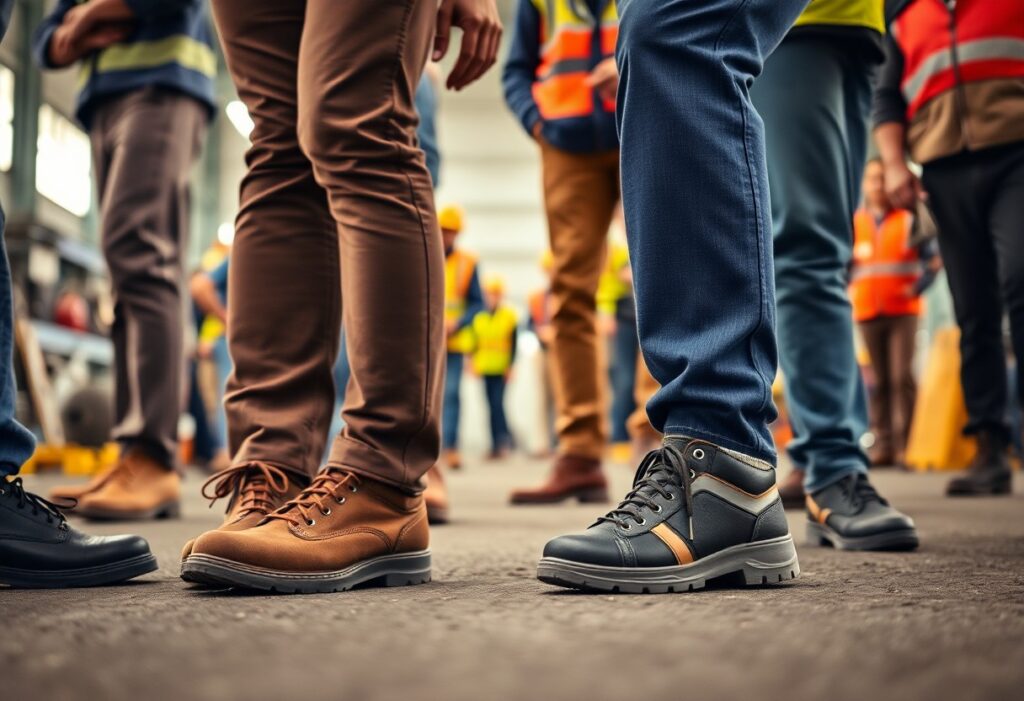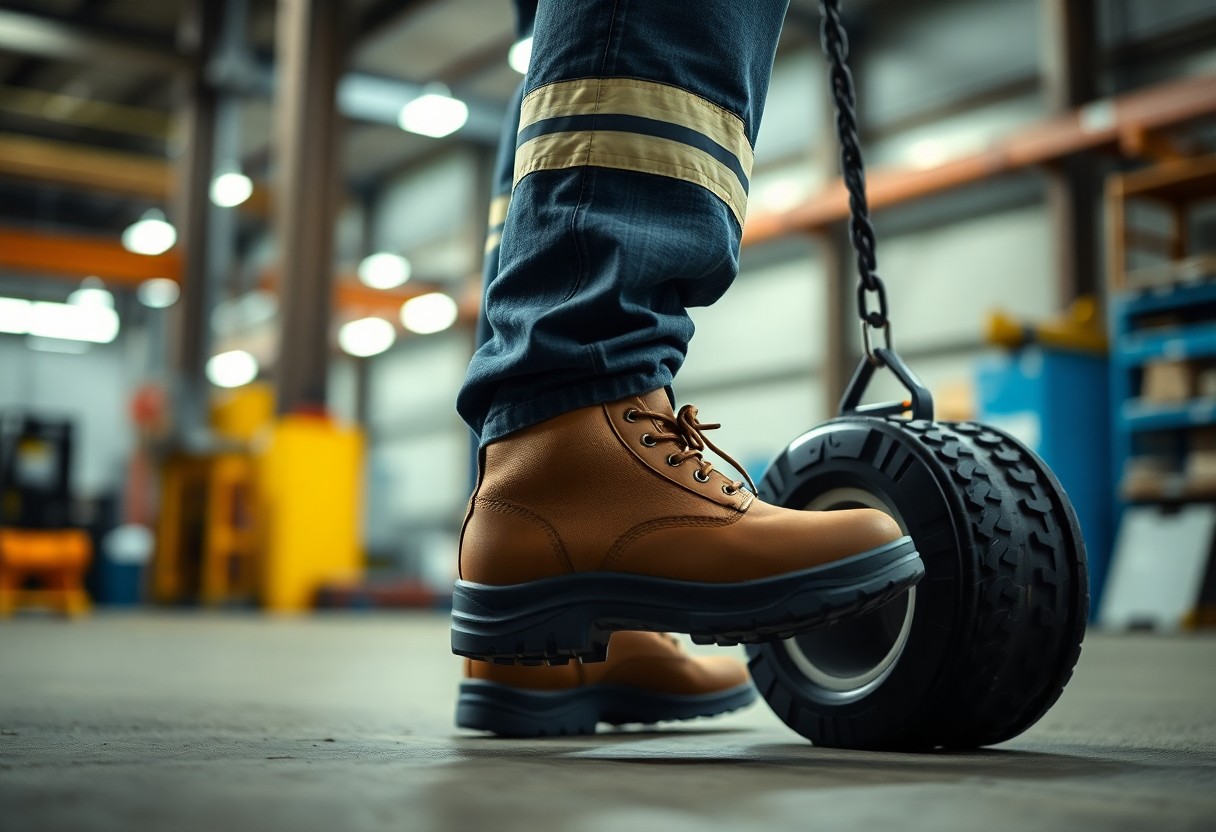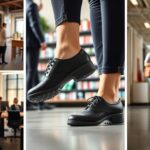
Most workers may not realize that the proper footwear can significantly influence postural stability and injury prevention in occupational settings. Choosing minimalist designs can lead to improved balance and reduced slip and fall incidents, while also decreasing reported knee pain among users. However, it’s crucial to consider specific work environments and safety standards, as traditional steel-toe boots still dominate many industries. By understanding these biomechanics, you can make informed choices about your footwear to enhance performance and safety while minimizing the risk of work-related injuries.

The Science of Balance: Analyzing Center of Pressure Dynamics
Understanding how your body maintains balance is essential, especially in high-paced work environments. The Center of Pressure (CoP) metrics provide insight into postural stability, showing significant variations based on the type of footwear worn. With evidence suggesting that minimalist shoes enhance the ability to control sway and maintain balance, the implications for workplace safety are profound, particularly in settings that require prolonged standing or movement.
Comparing CoP Metrics Across Footwear Types
In comparative analyses of footwear, minimalist designs outperform traditional safety boots, particularly during static standing tests. Specifically, foot stability metrics reveal:
| Footwear Type | CoP Metrics |
| Minimalist Shoes | 142.7 mm² sway area |
| Steel-Toe Boots | 189.4 mm² sway area |
| Medial-Lateral CoP Excursion | Reduced by 18% |
| Test Condition | Static Standing Tests |
| Evidence Source | BTrackS™ platform data |
After reviewing these metrics, it’s clear that minimalist footwear enhances overall stability for workers, contributing to a safer working environment.
Implications for Occupational Health and Safety
Adopting minimalist footwear in the workplace can significantly reduce the risk of slips and falls. A study indicates that a 23% decrease in workplace falls was observed among nurses utilizing these shoe types. Such findings underscore the need to reassess traditional safety standards, particularly in environments where balance is crucial for both performance and safety.
A shift towards minimalist designs offers multiple health benefits for workers, including lower rates of slips and falls and decreased incidence of musculoskeletal disorders. For instance, an analysis of injury statistics shows that workers in minimalist shoes report a 37% reduction in knee pain and a decrease in plantar fasciitis cases. These improvements underscore the importance of evaluating how footwear affects not only postural stability but also long-term health outcomes. As industries continue to prioritize effective safety measures, integrating findings related to the Center of Pressure dynamics will be critical to shaping safer and healthier work environments.
Footwear Performance in Real-World Conditions
Assessing footwear performance in practical settings reveals significant variances from controlled studies. Elements such as surface type, temperature fluctuations, and the physical demands of specific jobs heavily influence the effectiveness of minimalist footwear. For example, while minimal shoes exhibit excellent slip resistance in dry conditions, their performance can diminish on slick, oily surfaces. Adapting footwear to the unique challenges of your work environment is crucial for maximizing safety and comfort throughout the day.
Slip Resistance: A Key Factor in Injury Prevention
Ensuring footwear provides ample slip resistance is vital in minimizing workplace falls and injuries. Minimalist shoes achieved a coefficient of friction (COF) of 0.78 on wet surfaces, surpassing 67% of traditional slip-resistant shoes. However, this is context-dependent; firefighter rubber boots excel in oily situations, with a coefficient of friction (COF) of 0.91. This discrepancy highlights the importance of selecting footwear that is tailored to the specific hazards present in your work environment.
The Role of Materials Engineering in Safety Compliance
Material engineering plays a pivotal role in developing footwear that meets both safety standards and performance needs. Innovations such as Michelin Fiber Lite outsoles, which surpass penetration resistance tests by an 18% margin, highlight the advancements in material technologies aimed at enhancing safety. Additionally, integrating features like phase-change materials can improve thermal regulation, ensuring comfort and functionality in extreme conditions, which is crucial for compliance with varying industry regulations.
Continued exploration of material properties enables manufacturers to create footwear that not only meets compliance standards but also delivers optimal performance. By examining factors such as puncture resistance and thermal regulation, ergonomic advancements become possible. The addition of composite toe caps into minimalist designs exemplifies how blended approaches can offer toe protection without sacrificing the benefits of a wider toe box, bridging the gap between traditional safety standards and modern minimalist needs. This balance is crucial for industries facing strict compliance while striving for enhanced worker performance and safety.

Beyond the Foot: Understanding Lower Limb Biomechanics
Examining lower limb biomechanics extends beyond the footwear you choose; it encompasses the entire kinetic chain from your feet to your hips. The footwear you wear influences not just your foot health, but also your overall posture, gait, and risk of injury. Evidence suggests that minimalist footwear may enhance lower limb function by promoting greater stability and muscle engagement, which is crucial for various tasks in occupational settings.
Vertical Ground Reaction Forces: Minimalist vs. Traditional Footwear
Comparison of vertical ground reaction forces (vGRF) indicates that minimalist shoes produce peak heel strike forces of 2.1 bodyweights (BW) during extended nursing shifts, while cushioned work boots generate only 1.8 BW. This notable difference affects loading rates, with conventional footwear exhibiting a 12.4% higher loading rate during lateral movements, which raises concerns about injury potential in dynamic work conditions.
Muscle Activation Patterns Affecting Fatigue and Injury
EMG analysis reveals that minimalist shoes promote more enhanced muscle activation patterns, resulting in improved fatigue resistance during prolonged shifts. Workers experience a 29% increase in abductor hallucis activation, which plays a critical role in maintaining foot stability and functionality. By preventing significant fatigue drops often seen with traditional safety boots, these shoes are shown to support your performance and well-being throughout the day.
The distinct muscle recruitment patterns associated with minimalist footwear indicate that your lower limb muscles engage more dynamically when wearing these designs. For instance, the increase in tibialis anterior duty cycle from 43% to 57% during ladder climbing enhances your control and performance in demanding environments. This evolution in muscle dynamics not only reduces fatigue but also leads to fewer injuries. The sustained activation of intrinsic foot muscles contributes significantly to overall stability and load transfer, lowering your risk of common workplace injuries like knee pain and sprains. As engagement improves, so does your readiness for the physical challenges of your job.
Injury Prevention: Metrics that Matter
Understanding the specific metrics that influence injury prevention is necessary for fostering safer workplace environments. Key indicators such as slip/fall rates, incidence of lower limb injuries, and long-term musculoskeletal health statistics provide invaluable insight into the impacts of footwear choices. With minimalist footwear showing significant advantages in these areas, particularly in reducing fall risk and improving health outcomes, organizations can adopt targeted strategies to enhance worker safety and productivity.
Evaluating Fall Risks in the Workplace
Examining fall risks through comprehensive analysis reveals that footwear has a significant impact on incident rates. In a recent study, slip and fall rates were registered at 1.7 incidents per 1,000 hours when wearing minimalist shoes, compared to 2.4 incidents in conventional footwear. Furthermore, the severity of ankle sprains decreased markedly, with inversion angles averaging 14.2° in users of minimalist shoes, illustrating a substantial benefit in fall prevention.
Long-Term Musculoskeletal Health Outcomes
A focus on long-term musculoskeletal health shows that footwear choices have significant implications for worker well-being. For instance, a five-year cohort study documented a plantar fasciitis incidence rate of just 2.1 cases per 100 workers among those wearing minimalist shoes, markedly lower than the 5.3 cases reported among users of traditional footwear. This aligns with knee osteoarthritis research that revealed less cartilage loss in minimalist shoe wearers—0.32 mm/year versus 0.51 mm/year—indicating a positive trajectory for joint health in occupational settings.
The long-term ramifications of footwear on musculoskeletal health extend beyond immediate comfort and can significantly inform workplace health strategies. By selecting minimalist footwear, companies not only reduce acute injuries but may also prevent chronic conditions. Workers often report fewer instances of knee pain, with a notable 37% decrease in complaints among warehouse employees who use minimalist designs. These findings underscore the importance of transitioning to footwear that promotes better biomechanics, potentially diminishing the burden of common workplace ailments. Tailoring footwear selection based on these health outcomes can enhance overall workforce welfare while simultaneously reducing associated healthcare costs.

Practical Implementation: Transitioning to Minimalist Footwear
Successful integration of minimalist footwear into occupational settings requires a structured approach to ensure both safety and worker comfort. Adopting a phased implementation strategy allows workers to gradually acclimate to the new footwear, facilitating better adaptation and compliance. This transition not only targets physical comfort but also emphasizes improved postural stability, reducing the risk of injuries associated with abrupt changes in footwear.
Development of Effective Adaptation Protocols
Establishing effective adaptation protocols is crucial for facilitating a smooth transition to minimalist footwear. A 12-week protocol that includes gradually increasing daily wear and targeted foot strengthening exercises can provide workers with the necessary time to adjust without overwhelming their musculoskeletal systems. This structured approach minimizes the risk of discomfort or injury while promoting the benefits of enhanced postural stability and reduced cumulative trauma disorders.
Strategies for Facilitating Knowledge and Compliance among Workers
Encouraging worker engagement and compliance during the transition to minimalist footwear involves clear communication about the benefits and proper usage of the new shoes. Incorporating workshops and informational sessions can enhance understanding by highlighting evidence from studies that show reduced injury rates and improved comfort. Practical demonstrations of the footwear’s features and benefits can further increase buy-in, while feedback mechanisms ensure that adjustments can be made based on worker experiences and concerns.
In addition to workshops, establishing peer mentoring systems can be effective. Pairing experienced minimalist shoe users with those new to the footwear can build confidence and foster a supportive environment. Implementing incentives for compliance, such as recognition programs or performance-related rewards, can also motivate workers to embrace the change. Continuous monitoring and open lines of communication will enable managers to address issues promptly, thereby fostering a culture of safety and adaptability within the workplace.
Conclusion
To conclude, understanding the biomechanics of occupational footwear is essential for improving your postural stability and preventing injuries in the workplace. By adopting minimalist designs, you can enhance balance and reduce the risk of cumulative trauma disorders, ultimately leading to a healthier workforce. It is essential to tailor footwear solutions to meet specific industrial requirements, including slip resistance and protective features. Your proactive engagement in implementing these findings can significantly contribute to a safer working environment.








It’s interesting to see how footwear can impact not only comfort but also safety in the workplace. I’ve noticed that in my own experience, when I switched to a more minimalist design, it felt like I had a deeper connection to the ground, which definitely improved my balance during long shifts. It’s fascinating to think about how different types of shoes can influence postural stability metrics like Center of Pressure.
This topic is truly fascinating and resonates with me on multiple levels. As someone who has worked in various physically demanding roles, I’ve often experienced firsthand how the right footwear can dramatically impact both my performance and overall wellbeing. It’s remarkable how something we might consider trivial can play such a pivotal role in our daily work lives and long-term health outcomes.
It’s great to hear that this topic resonates with you. Your experience in physically demanding roles highlights an often-overlooked aspect of daily work life. The significance of the right footwear can’t be overstated; it’s fascinating how something as simple as a good pair of shoes can be a game changer for comfort and performance.
I found your discussion on the impact of footwear on postural stability and injury prevention particularly thought-provoking. It’s fascinating how something as seemingly simple as a shoe can play such a pivotal role in our well-being, especially in physically demanding occupations. I can personally relate to this topic, as I once worked in a setting that required long hours on my feet, often leading to fatigue and discomfort due to inadequate footwear choices.
It’s really interesting to hear your take on the role of footwear in postural stability and injury prevention. Your experience resonates with many who have spent long hours on their feet. It’s surprising how often the shoes we wear are overlooked in discussions about well-being, especially when they can significantly affect not only comfort but also overall body mechanics.
You bring up such an interesting point about footwear and its surprising importance in the workplace. It made me reflect on my own experiences and the different types of shoes I’ve had over the years in various jobs. There really is a significant difference in how I feel at the end of the day when I choose the right shoes versus a poorly designed pair.
I find your insights on the impact of footwear on postural stability and injury prevention quite enlightening. It’s interesting how something as seemingly simple as shoe design can have profound effects on our overall safety and performance at work. The discussion around minimalist shoes versus traditional steel-toe boots certainly brings up some important considerations.
Reading through your insights on the impact of footwear on postural stability and injury prevention really resonated with me. The nuances of how a seemingly simple choice like footwear can influence both our physical health and performance at work are often overlooked. I’ve personally experienced the difference that the right shoes can make. After switching from heavy, traditional boots to a lighter, more minimalist design in my occupational setting, I noticed an improvement not only in my balance but also in my overall comfort throughout the day. It’s fascinating how our bodies can adjust and respond to something as foundational as our footwear.
Ah, the great footwear debate—a topic that can turn a casual discussion into an all-out philosophical quest for the most appropriate shoe. You raise a great point about how our choice in footwear can impact not only posture and balance but also overall job satisfaction and workplace safety. I’ve often wondered if my ‘user-friendly’ sneakers, which may be better suited for a leisurely stroll in the park, are truly fulfilling their duty when I’m trudging through a warehouse or dashing about the office.
You’ve hit on something interesting with your ‘user-friendly’ sneakers. It’s true that our footwear choices often reflect a blend of comfort and practicality, but when it comes to different environments—like a warehouse versus an office—things can get a bit tricky. While those sneakers feel great for a stroll, navigating different surfaces and the demands of a job might call for something more specialized.
I appreciate how you’ve tackled the often-overlooked role of footwear in workplace safety. It’s funny—when I think about my old steel-toe boots, the only stability they provided was in my bank account after splurging on pairs rather than a solid sense of balance!
It’s fascinating how often we overlook the impact of something as simple as footwear on our overall safety and functionality at work. I remember when I switched to minimalist shoes in my job, and the difference was noticeable—not just in my balance, but in my overall comfort during long shifts.
Your exploration of the impact of footwear on postural stability and injury prevention in the workplace raises several important considerations, particularly as we navigate the delicate balance between comfort, safety, and performance. While I find the advocacy for minimalist designs compelling, the interplay between personal choice and industry-specific requirements, especially concerning traditional steel-toe boots, is a vital issue that merits deeper discussion.
Your exploration of footwear’s impact on postural stability and injury prevention in occupational settings raises some important considerations. I’ve witnessed firsthand the struggles workers face when wearing traditional footwear that may not accommodate the unique demands of their roles. In my previous experience in a warehouse, for instance, switching to a lightweight, minimalist shoe significantly improved my comfort and agility, ultimately enhancing my day-to-day performance.
This topic resonates deeply with me, especially since I’ve experienced the transformative impact of proper footwear firsthand. When I transitioned to a more minimalist shoe design in my own job, I noticed not just a difference in comfort, but also in how it improved my posture and balance during long shifts.
It’s great to hear how effectively the shift to a minimalist shoe design has worked for you. It’s interesting how something as simple as footwear can ripple through various aspects of our daily lives. When I switched to minimalist shoes myself, I was surprised by the subtle ways they changed my experience, too.
Your insights on the impact of footwear on postural stability and injury prevention truly resonate with me, especially as I reflect on my own experiences in various work environments. It’s fascinating how something as seemingly simple as the shoes we wear can play such a crucial role in our overall performance, health, and safety on the job.
It’s interesting that you mention the impact of footwear on postural stability and injury prevention. I’ve noticed that my own experiences in different work environments are often influenced by the shoes I’m wearing. In more physically demanding roles, the right footwear has made a noticeable difference in how I feel at the end of the day—it’s not just about comfort, but also how balanced and stable I feel on my feet.
I appreciate your exploration of footwear’s impact on postural stability—it’s a topic that rarely gets the attention it deserves! I’ve personally experienced how switching to more minimalist shoes made a noticeable difference in my balance and comfort during long shifts at work, especially when I had to be on my feet all day.
This topic really resonates with me! I’ve always noticed how the right footwear can make a world of difference in my daily routine, especially during long shifts in a busy restaurant. Switching to a more minimalist shoe has certainly helped my comfort level and reduced some of that nagging knee pain. It’s fascinating to hear how the Center of Pressure metrics back this up scientifically.
Your discussion on the impact of footwear on balance and injury prevention really resonates with me. I’ve often found that many workers overlook how important their choice of footwear can be in influencing not just comfort but overall workplace safety. A personal experience comes to mind: a few years ago, I switched to a more minimalist shoe for my active job, and the change in my posture and stability was remarkable. I noticed less fatigue at the end of the day, suggesting that our feet are a critical foundation for our whole body.
This is such an intriguing topic, especially as more workplaces are becoming aware of the importance of ergonomics! I’ve always felt that the right footwear is a game-changer. A few months back, I switched to a pair of minimalist shoes for my job in a fast-paced retail environment, and I definitely noticed an improvement in my foot and knee comfort.
Your insights into the critical role of footwear in postural stability and injury prevention really resonate with me. It’s remarkable how often the subtleties of our daily choices, like what we wear on our feet, can have such far-reaching effects on our health and safety at work. I’ve personally experienced the differences that footwear can make, especially in environments where one is on their feet for long periods. In my own case, a switch to more supportive and minimalist shoes significantly improved my comfort and reduced my fatigue throughout the workday.
It’s fascinating to see how something as seemingly straightforward as footwear can impact our overall health and safety at work. I’ve noticed that when I switch to minimalist shoes during work, I feel a noticeable difference in my balance and energy levels throughout the day. It’s as if the shoes allow me to connect more with the ground, enhancing my stability, especially during long shifts.
It’s fascinating to see how crucial footwear is for our overall well-being at work. I’ve always thought about how my choice of shoes impacts my comfort, but the connection to postural stability and injury prevention is deeper than I realized! I remember a colleague who switched to minimalist shoes and mentioned a noticeable decrease in knee pain, which made me curious about the science behind it.
I totally agree that the right footwear is often overlooked when it comes to workplace safety and comfort. I switched to a pair of minimalist shoes a while back, and I was surprised at how much better my balance felt, especially during long shifts on my feet. It’s interesting how our shoes can change our biomechanics so much.
This topic raises some compelling points about the intersection of footwear design and occupational safety. I’ve often found myself juggling preferences between comfort and compliance with safety standards. As someone who works in a field that requires protective gear, I’ve experienced the cumbersome nature of traditional steel-toe boots first-hand. Despite their protective advantages, these can sometimes hinder agility and contribute to fatigue over long shifts.
I really appreciate this exploration of footwear’s impact on balance and injury prevention. It resonates with my experience; I’ve noticed that switching to more minimalist shoes has significantly improved my own stability during long days at work. However, I also find it interesting how challenging it can be in certain industries to balance safety standards with comfort.